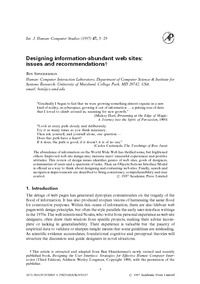Designing information-abundant websitesissues and recommendations
Erstpublikation in: International Journal of Human-Computer Studies, Vol. 47, No. 1, July, pp. 5-29
Publikationsdatum:
|
 |
 Diese Seite wurde seit 6 Jahren inhaltlich nicht mehr aktualisiert.
Unter Umständen ist sie nicht mehr aktuell.
Diese Seite wurde seit 6 Jahren inhaltlich nicht mehr aktualisiert.
Unter Umständen ist sie nicht mehr aktuell.
 Zusammenfassungen
Zusammenfassungen
 The abundance of information on the World Wide Web has thrilled some, but frightened
others. Improved web site design may increase usersÕ successful experiences and positive
attitudes. This review of design issues identiÞes genres of web sites, goals of designers,
communities of users and a spectrum of tasks. Then an Objects/Actions Interface Model
is o¤ered as a way to think about designing and evaluating web sites. Finally, search and
navigation improvements are described to bring consistency, comprehensibility and user
control.
The abundance of information on the World Wide Web has thrilled some, but frightened
others. Improved web site design may increase usersÕ successful experiences and positive
attitudes. This review of design issues identiÞes genres of web sites, goals of designers,
communities of users and a spectrum of tasks. Then an Objects/Actions Interface Model
is o¤ered as a way to think about designing and evaluating web sites. Finally, search and
navigation improvements are described to bring consistency, comprehensibility and user
control. The World Wide Web in 1997 was a frightening abundance of information. In this article Ben Shneiderman argues that better interface design might improve users’ attitude towards the Web. The article is based on a chapter of his book "Designing the User Interface: Strategies for Effective Human-Computer Interaction". Seven years have passed; the web is an even bigger abundance of information and more than ever lacks consistency in interaction design.
The World Wide Web in 1997 was a frightening abundance of information. In this article Ben Shneiderman argues that better interface design might improve users’ attitude towards the Web. The article is based on a chapter of his book "Designing the User Interface: Strategies for Effective Human-Computer Interaction". Seven years have passed; the web is an even bigger abundance of information and more than ever lacks consistency in interaction design.
Web sites are often designed according to the originator’s identity, goals, and intentions. But as in any user-interface design, the question to address is: who are the users and what are their tasks? When creating a completely new web site assumptions about potential users should be made. The distinction between first-time, intermittent, and frequent users is very important. The users’ tasks can range from fact-finding to unstructured browsing and exploring the available information. This is very different from traditional computer tasks (e.g. word processing) where the tasks are much clearer.
Shneiderman describes the Objects/Actions Interface (OAI) model with respect to web sites. Information objects are aggregated in unstructured lists, linear structures, tables, trees, etc. Actions are, for example, looking for a name in an alphabetical list, scanning a list of articles, reading a paragraph or following a hyperlink. Unfortunately, the OAI model does not tell what information design is best suited for what user action.
The case of the Library of Congress’ web site illustrates that searching is a very important user action. A good search system indicates whether stemming, stop word elimination or other transformations have been applied. Visualisation of the search results might allow the users to visually browse and filter the results. Another important user action is navigation. Shneiderman proposes site maps and other visualisations of web sites, but he also states that visualisations can be complex and confusing.
The World Wide Web has changed a lot since 1997, but Shneiderman’s design recommendations are still helpful, for instance on how to reduce users’ disorientation or how to structure the search process. His OAI model is a useful tool to analyse user actions and to structure content. However, the model does not tell how to design the interface. From today’s point of view navigation is emphasised too much. The success of Google’s search engine has heavily influenced the way people surf the web. Consequently, few web sites have a hierarchical thesaurus, many have a site map, but almost every large web site has a search function.
Quelle: http://www.elearning-reviews.org/
 Dieser Text erwähnt ...
Dieser Text erwähnt ...
 Personen KB IB clear | Jakob Nielsen , Ben Shneiderman | |||||||||||||||||||||||||||
 Begriffe KB IB clear | HCI/MMI (Human-Computer-Interaction)Human-Computer-Interaction
,  Informationsflut Informationsflut information overflow
, information overflow
,  Informationsflut im WWW
, Informationsflut im WWW
,  Usability Usability Usability
, Usability
,  User Interface (Benutzerschnittstelle) User Interface (Benutzerschnittstelle) User Interface
, Web-Auftritt
, User Interface
, Web-Auftritt
,  WWW (World Wide Web) WWW (World Wide Web) World Wide Web World Wide Web
| |||||||||||||||||||||||||||
 Bücher |
|
 Zitationsgraph
Zitationsgraph
 Zitationsgraph (Beta-Test mit vis.js)
Zitationsgraph (Beta-Test mit vis.js)
 Volltext dieses Dokuments
Volltext dieses Dokuments
 |  Designing information-abundant websites: Artikel als Volltext ( Designing information-abundant websites: Artikel als Volltext ( : :  , 4335 kByte; , 4335 kByte;  : :  Link unterbrochen? Letzte Überprüfung: 2020-11-28 Letzte erfolgreiche Überprüfung: 2019-05-11) Link unterbrochen? Letzte Überprüfung: 2020-11-28 Letzte erfolgreiche Überprüfung: 2019-05-11) |
 Anderswo suchen
Anderswo suchen 
 Beat und dieser Text
Beat und dieser Text
Beat war Co-Leiter des ICT-Kompetenzzentrums TOP während er Dieser Text ins Biblionetz aufgenommen hat. Die bisher letzte Bearbeitung erfolgte während seiner Zeit am Institut für Medien und Schule. Beat besitzt kein physisches, aber ein digitales Exemplar. Eine digitale Version ist auf dem Internet verfügbar (s.o.). Es gibt bisher nur wenige Objekte im Biblionetz, die dieses Werk zitieren.










 Biblionetz-History
Biblionetz-History